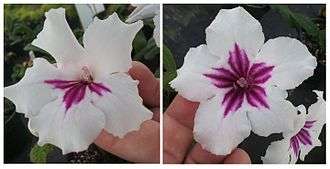Floral symmetry
Floral symmetry describes whether, and how, a flower, in particular its perianth, can be divided into two or more identical or mirror-image parts.

Uncommonly, flowers may have no axis of symmetry at all, typically because their parts are spirally arranged.
Actinomorphic
Most flowers are actinomorphic ("star shaped", "radial"), meaning they can be divided into 3 or more identical sectors which are related to each other by rotation about the centre of the flower. Typically, each sector might contain one tepal or one petal and one sepal and so on. It may or may not be possible to divide the flower into symmetrical halves by the same number of longitudinal planes passing through the axis: Oleander is an example of a flower without such mirror planes. Actinomorphic flowers are also called radially symmetrical or regular flowers. Other examples of actinomorphic flowers are the lily (Lilium, Liliaceae) and the buttercup (Ranunculus, Ranunculaceae).
Zygomorphic

Zygomorphic ("yoke shaped", "bilateral" – from the Greek ζυγόν, zygon, yoke, and μορφή, morphe, shape) flowers can be divided by only a single plane into two mirror-image halves, much like a yoke or a person's face. Examples are orchids and the flowers of most members of the Lamiales (e.g., Scrophulariaceae and Gesneriaceae). Some authors prefer the term monosymmetry or bilateral symmetry.[1]
Asymmetry
A few plant species have flowers lacking any symmetry, and therefore having a "handedness". Examples: Valeriana officinalis and Canna indica.[2]
Differences
Actinomorphic flowers are a basal angiosperm character; zygomorphic flowers are a derived character that has evolved many times.[3]
Some familiar and seemingly actinomorphic so-called flowers, such as those of daisies and dandelions (Asteraceae), and most species of Protea, are actually clusters of tiny (not necessarily actinomorphic) flowers arranged into a roughly radially symmetric inflorescence of the form known as a head, capitulum, or pseudanthium.
Peloria

Peloria or a peloric flower is the aberration in which a plant that normally produces zygomorphic flowers produces actinomorphic flowers instead. This aberration can be developmental, or it can have a genetic basis: the CYCLOIDEA gene controls floral symmetry. Peloric Antirrhinum plants have been produced by knocking out this gene.[3] Many modern cultivars of Sinningia speciosa ("gloxinia") have been bred to have peloric flowers as they are larger and showier than the normally zygomorphic flowers of this species.
Charles Darwin explored peloria in Antirrhinum (snapdragon) while researching the inheritance of floral characteristics for his The Variation of Animals and Plants under Domestication.[4] Later research, using Digitalis purpurea, showed that his results[5] were largely in line with Mendelian theory.[6]
Symmetry groups
If we consider only those flowers which consist in a single flower, rather than a flower head or inflorescence, we can group the flowers into a relatively small number of 2D symmetry groups. Monocots are identifiable by their trimerous petals, thus monocots often have rotational symmetry of order 3. If the flower also has 3 lines of mirror symmetry the group it belongs to is the dihedral group D3. If not, then it belongs to the cyclic group C3. Eudicots with tetramerous or pentamerous petals may have rotational symmetry of order 4 or 5. Again, whether they also have mirror planes decides whether they belong to dihedral (D4 and D5) or cyclic groups (C4 or C5). The sepals of some monocot flowers develop to replicate the petals, thus, superficially, certain monocots can appear to have rotational symmetry of order 6 and belong to either symmetry group D6 or C6. However, flower symmetry is rarely perfect.
References
- Craene 2010, p. 25.
- Weberling, Focko (1992). Morphology of Flowers and Inflorescences. Cambridge University Press. p. 19. ISBN 0-521-25134-6.
- Losos, J.B.; Mason, K.A; Singer, S.R. Biology (8th ed.). New York: McGraw Hill.
- Darwin 1868, pp. 33–34
- Darwin 1868, p. 46
- Keeble, Frederick; Pellew, C; Jones, WN (1910). "The Inheritance of Peloria and Flower-Colour in Foxgloves (Digitalis purpurea)". New Phytologist. 9 (1–2): 68–77. doi:10.1111/j.1469-8137.1910.tb05554.x. JSTOR 2427515.
Bibliography
- Craene, Louis P. Ronse De (2010), Floral diagrams: an aid to understanding flower morphology and evolution, Cambridge: Cambridge University Press, ISBN 9780521493468
- Darwin, Charles (1868). The variation of animals and plants under domestication. II. London: John Murray.CS1 maint: ref=harv (link)
- Endress, P. K. (February 2001). "Evolution of floral symmetry". Curr. Opin. Plant Biol. 4 (1): 86–91. doi:10.1016/S1369-5266(00)00140-0. PMID 11163173.
- Neal P. R.; Dafni A.; Giurfa M. (1998). "Floral symmetry and its role in plant-pollinator systems: terminology, distribution, and hypotheses". Annu Rev Ecol Syst. 29: 345–373. doi:10.1146/annurev.ecolsys.29.1.345. JSTOR 221712.

.jpg)